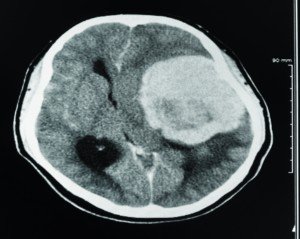If you had a non-contrast CT scan of your head for whatever reason, such as you fell on your head and feel sick, would it necessarily show a brain tumor if you had one?
“The test of choice to evaluate for brain tumor is the MRI with and without the contrast,” says neurosurgeon Charles Park, MD, Director of The Minimally Invasive Brain and Spine Center at Mercy Medical Center in Baltimore.
“CT’s are usually better to assess the bone related problems and MRI is better for the soft tissue,” says Dr. Park.
However, the CT scan can be used as part of a diagnostic assessment if a brain tumor is suspected.
According to hopkinsmedicine.org, a CT scan “can be helpful in diagnosing some types of brain tumors,” particularly “those near or involving bone.”
The CAT scan can also show bleeding, swelling, bone and tissue calcification that would be caused by a cancer.
If a person has a seizure or exhibits some other alarming sudden symptom such as cognitive impairment, a family member is apt to get that person to the emergency room.
A CT scan will be ordered to find out what’s going on. It will generate an image much faster than will an MRI. Its speed makes it the head scan of choice in emergency situations.
Contrast Dye with the CT Scan?
Dr. Park says, “Using contrast for CT usually is better, since brain tumor will usually enhance or gets brighter on contrast CT.
“Non-contrast may hint at an abnormality but not as conclusive as enhanced CT or MRI.”
The MRI is the gold standard for diagnosing most brain tumors. A contrast dye is used.
The cancerous mass usually “soaks up more dye than normal brain tissue,” says hopkinsmedicine.org.
This will clearly show up on the scan. However, there’s the occasional cancer mass that will not absorb more dye than the surrounding tissue.
CT scans without any contrast are terrific for showing bleeding in the brain from head trauma, but not the mass of a tumor.
Dr. Park specializes in minimally invasive surgical techniques for treatment of conditions affecting the brain and spine. He’s skilled in advanced procedures and techniques that utilize innovative computer technology and image-guided surgery systems.
 Lorra Garrick has been covering medical, fitness and cybersecurity topics for many years, having written thousands of articles for print magazines and websites, including as a ghostwriter. She’s also a former ACE-certified personal trainer.
Lorra Garrick has been covering medical, fitness and cybersecurity topics for many years, having written thousands of articles for print magazines and websites, including as a ghostwriter. She’s also a former ACE-certified personal trainer.











































